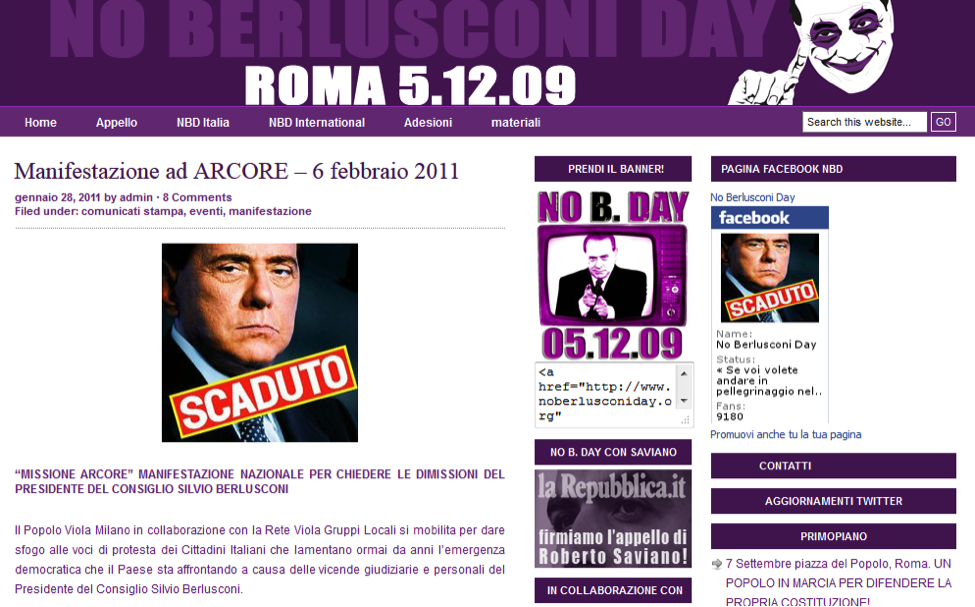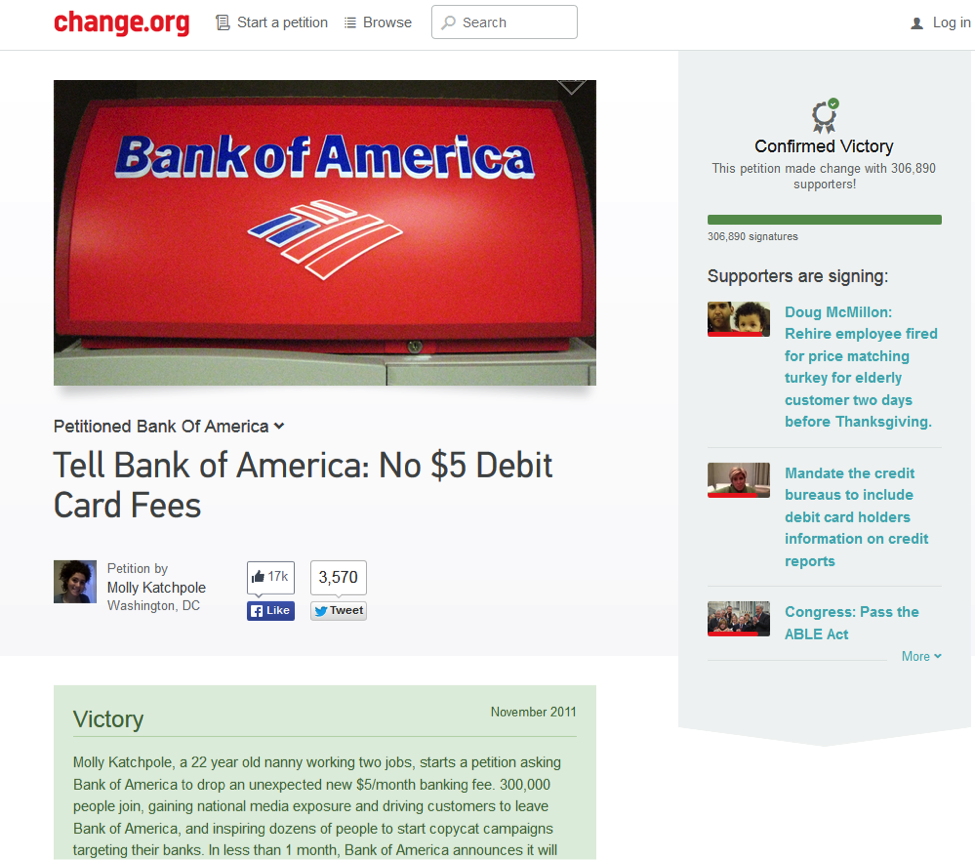
 The Purple People (Il Popolo Viola) movement was started in 2009 by a group of unidentified Italian bloggers who wanted to promote their anti-Silvio Berlusconi messages and call for his resignation. These activists orchestrated a national demonstration called No Berlusconi Day, designing a webpage and Facebook fan page to promote it. The movement gained significant traction, with the unofficial Il Popolo Viola Facebook page amassing 456,000 likes (a statement in and of itself for the degree of support). While the movement didn’t result in Berlusconi’s resignation (a stated goal), estimations of attendance at the actual rally were anywhere from 10,000 to 500,000 participants.
The Purple People (Il Popolo Viola) movement was started in 2009 by a group of unidentified Italian bloggers who wanted to promote their anti-Silvio Berlusconi messages and call for his resignation. These activists orchestrated a national demonstration called No Berlusconi Day, designing a webpage and Facebook fan page to promote it. The movement gained significant traction, with the unofficial Il Popolo Viola Facebook page amassing 456,000 likes (a statement in and of itself for the degree of support). While the movement didn’t result in Berlusconi’s resignation (a stated goal), estimations of attendance at the actual rally were anywhere from 10,000 to 500,000 participants.
 In December 2010, general political discontent launched a wave of protests across the Arab world. Because much of the protest surrounded over-powerful and corrupt regimes (dictators, absolute monarchies), citizens often struggled to get messages beyond state-run media channels to other Arab nations or to the Western world, where they knew support for liberation would be strong. Young Arab protestors took to social media. Efforts on Facebook and Twitter had been silenced quickly in prior movements, so protestors used cell phones to collect and disseminate videos and text message narratives of the events as they unfolded. From these same mobile devices, they blogged and shared photos of the events. These social media efforts to chronicle actions of the government and its police and security forces likely kept the government at bay and helped to protect protestors from extreme violence.
In December 2010, general political discontent launched a wave of protests across the Arab world. Because much of the protest surrounded over-powerful and corrupt regimes (dictators, absolute monarchies), citizens often struggled to get messages beyond state-run media channels to other Arab nations or to the Western world, where they knew support for liberation would be strong. Young Arab protestors took to social media. Efforts on Facebook and Twitter had been silenced quickly in prior movements, so protestors used cell phones to collect and disseminate videos and text message narratives of the events as they unfolded. From these same mobile devices, they blogged and shared photos of the events. These social media efforts to chronicle actions of the government and its police and security forces likely kept the government at bay and helped to protect protestors from extreme violence.
Madeline Storck (2011) wrote her dissertation on The Role of Social Media in Political Mobilsation: a Case Study of the January 2011 Egyptian Uprising, which covers the use of digital technology very thoroughly.
 Following the explosion of the Deepwater Horizon BP Oil Rig in the Gulf of Mexico in 2010, many organizations enlisted tools and users of social media to help them discern the extent of the damage and call for action to prevent further spills. Greenpeace announced on its blog that it would be sharing pictures through Flickr (a free image-sharing website) to document the disaster and ongoing clean-up efforts. Three other non-profit entities were highlighted in a Mashable.com piece on “How to Monitor the Gulf Oil Spill Using Social Media” (Livingston, 2010). Unlike the Greenpeace site, which called on users to view its coverage and pictures and sign a petition or lobby Congress for a complete end to oil drilling, the groups featured in the Mashable article called on users to upload their own images in what they called “grassroots mapping” of the disaster. The various social media technologies used in this collective response to the oil spill included Facebook, Twitter, Flickr, YouTube.
Following the explosion of the Deepwater Horizon BP Oil Rig in the Gulf of Mexico in 2010, many organizations enlisted tools and users of social media to help them discern the extent of the damage and call for action to prevent further spills. Greenpeace announced on its blog that it would be sharing pictures through Flickr (a free image-sharing website) to document the disaster and ongoing clean-up efforts. Three other non-profit entities were highlighted in a Mashable.com piece on “How to Monitor the Gulf Oil Spill Using Social Media” (Livingston, 2010). Unlike the Greenpeace site, which called on users to view its coverage and pictures and sign a petition or lobby Congress for a complete end to oil drilling, the groups featured in the Mashable article called on users to upload their own images in what they called “grassroots mapping” of the disaster. The various social media technologies used in this collective response to the oil spill included Facebook, Twitter, Flickr, YouTube.
 While certainly not a dire social or political movement, this activist campaign shows the way one person can impact an issue or cause using tools of social media. In 2011, Bank of America (BOA) announced it would begin charging debit card holders a $5 monthly fee. Twenty-two-year-old Molly Katchpole was outraged that the corporation that had just profited from a generous government bailout (she identified the American people as its benefactors) would turn around and require an additional $60/year payment from its account holders. She started an e-petition on Change.org, which quickly collected more than 300,000 signatures, prompting BOA (and other banks considering the same business model) to cancel plans for a monthly fee program.
While certainly not a dire social or political movement, this activist campaign shows the way one person can impact an issue or cause using tools of social media. In 2011, Bank of America (BOA) announced it would begin charging debit card holders a $5 monthly fee. Twenty-two-year-old Molly Katchpole was outraged that the corporation that had just profited from a generous government bailout (she identified the American people as its benefactors) would turn around and require an additional $60/year payment from its account holders. She started an e-petition on Change.org, which quickly collected more than 300,000 signatures, prompting BOA (and other banks considering the same business model) to cancel plans for a monthly fee program.